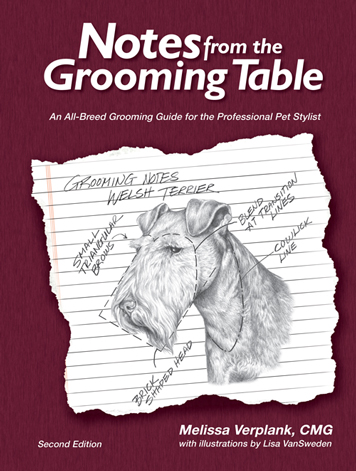 Did you know about half of all small businesses fail within the first four years? It’s a scary statistic, but fortunately, you’re not one of the fallen. Your books are full. You’re grooming steadily all day long. The phones are ringing off the hook – it’s a dream come true, right?
Did you know about half of all small businesses fail within the first four years? It’s a scary statistic, but fortunately, you’re not one of the fallen. Your books are full. You’re grooming steadily all day long. The phones are ringing off the hook – it’s a dream come true, right?
There can sometimes be a dark side to all of this success. Do you feel like no matter how hard you work, how efficiently you groom, you just can’t get ahead? Is your first available appointment still three weeks out – or more? Is your cancellation list getting longer and longer?
I’ll bet you’re tired.
Stressed.
Frustrated.
Wondering why you ever opened your own business.
After all, wasn’t it supposed to be fun and satisfying to finally be your own boss? Yet somehow, grooming all those cute little fluffy puppies has lost its appeal.
Sound familiar? I’ve been there more times than I care to admit!
What are you going to do?
The easy solution would be to hire another groomer. Unfortunately, finding someone talented, reliable, and a good fit for your team can be quite challenging. Most grooming schools have far more job requests than their graduates could fill. Placing an ad in any type of help wanted advertising outlet yields only crickets when it comes to finding anybody even remotely qualified to groom dogs and cats.
 This is an age-old problem. I don’t know of a single successful grooming business that has not faced this dilemma at some point.
This is an age-old problem. I don’t know of a single successful grooming business that has not faced this dilemma at some point.
Don’t fret. You have options. Some are more long-term solutions. Others can be implemented instantly for immediate relief.
- Train your own groomers and stylists from scratch.
- Delegate basic tasks.
- Hire an assistant.
- Become exclusive by raising your prices, which will instantly lighten your client load.
Training your own groomers and stylists from the ground up is a great long-term solution – and sometimes the only option. It’s not a quick fix, but it is something you will want to keep in the back of your mind for the future. If you opt to go this route, keep in mind it will typically take six months to a year to train to someone who can independently groom dogs.
If you are a salon owner, my guess is you wear many hats when it comes to running your business. What if you could have someone else do some of the NON-grooming related tasks? Hire someone full or part-time to do the tasks you really don’t need to be doing. Things like:
- cleaning
- laundry services
- running errands
- bookkeeping
- payroll
- data entry
 Delegate anything you can to assist with the smooth running of your business – or your home – which is not directly related to grooming.
Delegate anything you can to assist with the smooth running of your business – or your home – which is not directly related to grooming.
Training a grooming assistant is a great option. Having someone to help with the more elementary tasks of grooming pets isn’t as time-consuming or difficult as training a full-fledged groomer. Yet, a well-trained assistant can almost double your productivity. A large bulk of the time grooming dogs is eaten up in the wet room.
Yes, training an assistant takes time but you will make that time up quickly! It will go even faster if you utilize the Core Skills videos in the Learn2GroomDogs.com online library. Combine that with select sections from the first 80 pages of Notes From the Grooming Table – Second Edition, and you have a winning recipe for success. Let’s face it, half of the time spent grooming dogs is spent in the bathing, drying, and fluffing areas.
There are other benefits to having an assistant work with you. They can jump in to help with other simple tasks when you really need another set of hands. Wouldn’t it be great to have someone who could:
- help handle a challenging pet
- answer the phone
- run dogs and do potty breaks
- help with customers
- clean and sanitize
- do laundry
…the list could go on and on.
Many successful stylists just don’t want to deal with a staff. They want to keep it simple. Uncomplicated. Stress-free. Yet if you have way too many clients, the demands on your time and your sanity will be quickly tested.
 If the other three options are not good fits for you, maybe raising your prices and becoming exclusive is the best option. If you stop and do the math, it can be pretty enlightening. Raising your prices by $5 to $10 per dog will weed out your client load almost instantly, freeing up your time – and giving you time to breathe.
If the other three options are not good fits for you, maybe raising your prices and becoming exclusive is the best option. If you stop and do the math, it can be pretty enlightening. Raising your prices by $5 to $10 per dog will weed out your client load almost instantly, freeing up your time – and giving you time to breathe.
When you feel you could work twenty-four hours per day, seven days a week, and still not have sufficient time to get everything done – it’s time for a change. Situations like this are what contribute to safety issues, affect your personal life – maybe even your health.
Success is a great thing as long as you manage the growing pains of your business. If you don’t, the business is going to be running you instead of you running your company.
If you are one of the success stories with an abundance of pooches (or felines) coming through your doors, congratulations! Remember – managing growth is just as important as creating an amazing service for your customers. If you are feeling frustrated and stressed out, make the change you feel best fits your situation. Get off that work overload treadmill. Once you do, you might even enjoy your business again!
Has this ever happened to you? What did you do? Jump over to the Learn2GroomDogs Facebook page and tell us about it!
Happy Trimming!
~ Melissa
 “I have a (insert breed here). Do you know how to groom them correctly?”
“I have a (insert breed here). Do you know how to groom them correctly?” The Internet is an invaluable research tool. Use it wisely. Most breeds will have a parent club that hosts an official site for the breed. Spend a few minutes reviewing images of top winning dogs in their galleries. With a little luck, you may even find grooming directions or links to grooming directions from dedicated breeders.
The Internet is an invaluable research tool. Use it wisely. Most breeds will have a parent club that hosts an official site for the breed. Spend a few minutes reviewing images of top winning dogs in their galleries. With a little luck, you may even find grooming directions or links to grooming directions from dedicated breeders.
 As pet groomers and stylists, we get to see plenty of dogs. It’s rare and exciting to get a breed you are not familiar with. Most of us pros enjoy the challenge of learning about a new breed. Figuring out what we will need to do to make the dog look like it should – or could – look like if the owners allow you to groom it correctly.
As pet groomers and stylists, we get to see plenty of dogs. It’s rare and exciting to get a breed you are not familiar with. Most of us pros enjoy the challenge of learning about a new breed. Figuring out what we will need to do to make the dog look like it should – or could – look like if the owners allow you to groom it correctly. Have you seen the new American Kennel Club Complete Dog Book? It’s mammoth! When I grabbed mine, I questioned if I needed a roller cart just to carry it. (Just kidding… but the thought crossed my mind!)
Have you seen the new American Kennel Club Complete Dog Book? It’s mammoth! When I grabbed mine, I questioned if I needed a roller cart just to carry it. (Just kidding… but the thought crossed my mind!) It has been a long time since the last edition. With the AKC approving new breeds at a breakneck pace, it is nice to have an up-to-date (at least for the moment) reference. The AKC Complete Dog Book is the foundation of all great pet groomers and stylists. In comprehensive grooming schools around the country, it is the groundwork for the curriculum. It is at the root of every grooming competition. It is the foundation of every voluntary grooming certification program.
It has been a long time since the last edition. With the AKC approving new breeds at a breakneck pace, it is nice to have an up-to-date (at least for the moment) reference. The AKC Complete Dog Book is the foundation of all great pet groomers and stylists. In comprehensive grooming schools around the country, it is the groundwork for the curriculum. It is at the root of every grooming competition. It is the foundation of every voluntary grooming certification program. A client calls stating they own a breed that you have never groomed before. You’ve seen it at dog shows but have never had an opportunity to groom one. Or maybe you’ve never even heard of or seen the breed before.
A client calls stating they own a breed that you have never groomed before. You’ve seen it at dog shows but have never had an opportunity to groom one. Or maybe you’ve never even heard of or seen the breed before. Your next step is to look up the breed in reference books. If you have an American Kennel Club (AKC) Complete Dog Book (or a similar book from your country), start there. This will give you the official breed standard. Review the breed profile. Read about the history of the dog to gather clues about the dog. After a quick scan, you will have a good idea of the size, temperament, structure, and coat type of this new dog. Most will also have photos that accompany each breed. If you don’t have an official breed standard book handy, you can always look it up online.
Your next step is to look up the breed in reference books. If you have an American Kennel Club (AKC) Complete Dog Book (or a similar book from your country), start there. This will give you the official breed standard. Review the breed profile. Read about the history of the dog to gather clues about the dog. After a quick scan, you will have a good idea of the size, temperament, structure, and coat type of this new dog. Most will also have photos that accompany each breed. If you don’t have an official breed standard book handy, you can always look it up online. A positive attitude helps you deal more easily with daily affairs. It brings brightness into your life, making it easier to avoid worries and negative thinking.When you’re positive, you have a clear, calm mind that is open to possibilities and see opportunities where others see nothing.
A positive attitude helps you deal more easily with daily affairs. It brings brightness into your life, making it easier to avoid worries and negative thinking.When you’re positive, you have a clear, calm mind that is open to possibilities and see opportunities where others see nothing. Wikipedia defines lifelong learning as, “The ongoing, voluntary, and self-motivated pursuit of knowledge for either personal or professional reasons.”
Wikipedia defines lifelong learning as, “The ongoing, voluntary, and self-motivated pursuit of knowledge for either personal or professional reasons.” Successful pet professionals are achievers. You aren’t going to see successful pet grooming teams dragging around the shop. Nope. They are buzzing with activity. They are constantly on task, on schedule, and looking for a way to shave moments off any task without sacrificing quality. Their hands and feet are never still.
Successful pet professionals are achievers. You aren’t going to see successful pet grooming teams dragging around the shop. Nope. They are buzzing with activity. They are constantly on task, on schedule, and looking for a way to shave moments off any task without sacrificing quality. Their hands and feet are never still. Curiosity might have killed the cat, but a new study by psychologists suggests that curiosity is very good for people. If you want a rewarding career – be curious.
Curiosity might have killed the cat, but a new study by psychologists suggests that curiosity is very good for people. If you want a rewarding career – be curious. Being persistent after it seems like everything has failed is one of the hardest things to do. You just want to give up. Give up on the dog. Give up on a technique. Give up on yourself.
Being persistent after it seems like everything has failed is one of the hardest things to do. You just want to give up. Give up on the dog. Give up on a technique. Give up on yourself. If you want to be successful at your job and move up, you need to be passionate about your work. You need to be motivated and driven to be the best you can be. Passionate people love their work.
If you want to be successful at your job and move up, you need to be passionate about your work. You need to be motivated and driven to be the best you can be. Passionate people love their work. Passion is an emotion that comes from within you. It’s your enthusiasm. Your motivation. Your drive.
Passion is an emotion that comes from within you. It’s your enthusiasm. Your motivation. Your drive.














 After working professional in the pet grooming industry over 35 years, the only time I worry about dealing with clients is the Christmas holiday season.
After working professional in the pet grooming industry over 35 years, the only time I worry about dealing with clients is the Christmas holiday season.